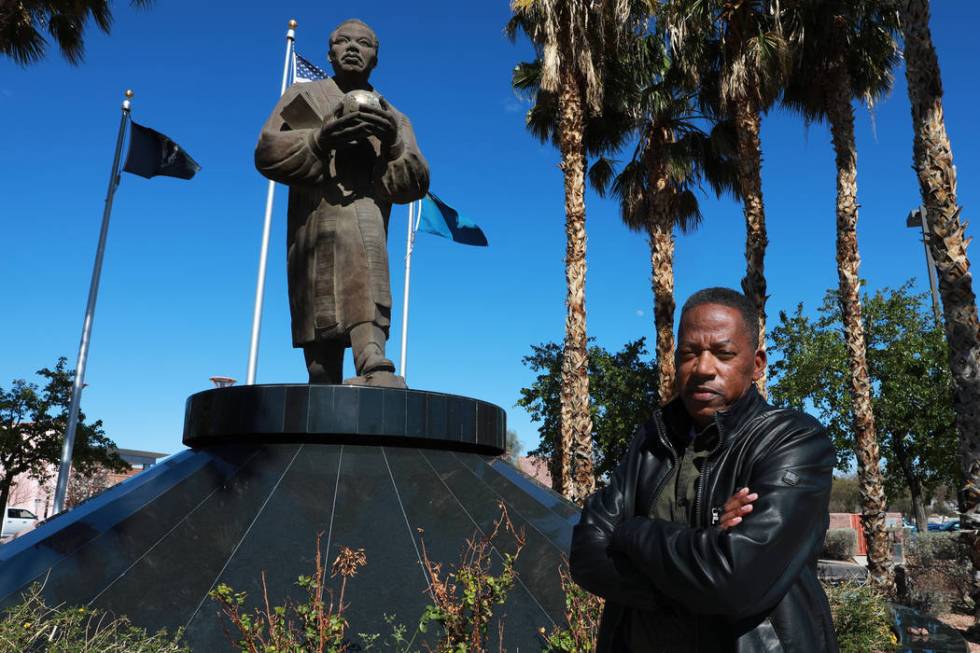MLK statue in North Las Vegas attracts rallies, vigils

Traffic zoomed by the intersection of Martin Luther King Boulevard and Carey Avenue as Walter “Mista” Kinchen approached in his red motorized wheelchair. He stopped to peer up at the 12-foot statue of the slain civil rights leader.
“This street used to divide us from white people,” the longtime resident of historic west Las Vegas said from behind his ruby-colored sunglasses. “I tell everyone that comes to Vegas there’s a Martin Luther King statue here. It represents that we asked for something, and they gave it to us.”
The 5-ton bronze statue, unveiled Jan. 20, 2001, by Martin Luther King III and sculptor Tina Allen, has turned into much more than a focal point in recent years.
The monument has become the center of protests, rallies and demonstrations, sparked most recently by police use of force. For some, it’s a place to pause and reflect, offering respite to the occasional homeless person.
On Wednesday, a group will gather at the statue at 6 p.m. to commemorate the 50th anniversary of King’s assassination.
Keeping the dream alive
“The community will come together to celebrate the life and the legacy of Dr. King in terms of making sure that ‘the dream’ is still alive,” said Clark County Commissioner Lawrence Weekly, who represents the district in which the statue is located. “And still making progress.”
Over the years, Weekly said, the statue has had to undergo major repairs — specifically to the water feature at its base, which was removed to conserve water.
On a recent Monday morning, Kinchen looked at the lawn surrounding the statue, strewn with shopping carts, piles of clothes and empty Pepsi cans. He shook his head.
Weekly acknowledged that some passers-by, like Kinchen, also take notice of the surrounding area.
“It’s become a trash collector,” Weekly said, adding that periodically, volunteers from the Martin Luther King Jr. Senior Center help clean up debris.
Real Property Management also visits and maintains the statue twice each week, a Clark County spokesman said.
Monument’s unveiling
Weekly was there that sunny Saturday in 2001 when officials removed the purple veil, exposing the statue. He said Allen had intimate access to the King family in drawing inspiration for the piece.
“It was something that stopped traffic,” he said. “Even in the 21st century, we’re marching, fighting, crying, dying and pushing toward prosperity in this country.”
In the statue, King’s hands hold the U.S. Constitution, the Bible and the world.
“He holds the world out to you as if to say, ‘I’ve given my all. Now it’s up to you. Treat the world gently. Remember what you do affects us all,’” Allen, who died in 2008, said on the day of the unveiling.
Harvey Munford, an assemblyman from 2005-15, also attended the ceremony.
Munford started as a teacher for the Clark County School District in 1966. He served as a mentor for young black men and women at a time when racial tensions were high.
After King was assassinated, they carried some resentment toward white people, he said.
“This was an act of violence of an individual,” Munford told them. “Don’t take it out on the entire population.”
King’s statue is a stimulating and motivating influence, Munford said.
“We need that,” he said. “Especially for young people coming up, when they drive by it’s sort of a beacon, like a light, a shining light, like a North Star.”
Two years of planning
The plan for the statue and the plaza was born after Yvonne Atkinson Gates, Weekly’s predecessor on the commission, brought it to the attention of her constituents.
Atkinson Gates, who grew up no more than a mile or two from the statue, said it was a way to lift and beautify that part of the community. King’s widow, Coretta Scott King, had approved the replica, she said.
It was a culmination of over two years of planning, erected on land donated by Chic Hecht, former U.S. senator and ambassador to the Bahamas. The statue cost $338,000, a county spokesman said, and Atkinson Gates said most of the money came from federal grants.
“It was people of all colors,” she said of the unveiling day. “We had an opportunity to have a blend of our community come and celebrate something very nice and meaningful to honor a man who had provided so much.”
Recently, she visited from Colorado and saw many people sitting by the statue, using it as a place for meditation and relaxation. But the homeless issue has gotten worse in that district and in the area where the statue stands, she said.
“He (King) would have wanted people in power to join together to solve a problem. Because homelessness is not an African-American problem,” she said. “Homelessness has no color boundaries.”
The artist’s vision
Capturing the likeness of a legend like King is a major feat, even for a woman who made it her goal to depict images of black icons, such as Alex Haley, Sojourner Truth and George Washington Carver.
Tina Allen’s youngest daughter, Tara, said her mother went to great lengths to understand her subjects. She sculpted the clay, which later was molded into the bronze statue of King, until she felt it became almost human.
Tara Allen said it was “doubly hard” for her mother, a black woman, to forge a career as an artist.
“And for her to sculpt someone like Martin Luther King Jr., who is in many ways the pinnacle of human character, it just doesn’t get better than that,” she said.
Tina Allen’s mission was to immortalize African-Americans and have them represented equally through visual arts, her daughter said.
A quote from her mother has stuck with her: “I want black children to say, ‘Greatness comes out of people who look like me.’”
Contact Briana Erickson at berickson@reviewjournal.com or 702-387-5244. Follow @brianarerick on Twitter.